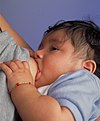Video:Breastfeeding
| Breastfeeding (Tutorial) | |
|---|---|
| On Commons | |
| Steps for video creation | |
| Step 1 | Preview my changes (10 sec) |
| Step 2 | Upload to Commons (10 min) |
Definition
Breastfeeding, also known as nursing, is the feeding of babies and young children with milk from a woman's breast.[1]

Initiation
Health professionals recommend that breastfeeding begin within the first hour of a baby's life and continue as often and as much as the baby wants.[2][3]

Frequency
During the first few weeks of life babies may nurse roughly every two to three hours, and the duration of a feeding is usually ten to fifteen minutes on each breast.[4]

Frequency in older children
Older children feed less often.[5]

Pumping
Mothers may pump milk so that it can be used later when breastfeeding is not possible.[1]

Benefits
Breastfeeding has a number of benefits to both mother and baby, which infant formula lacks.[3][6]

Benefits for baby
Deaths of an estimated 820,000 children under the age of five could be prevented globally every year with increased breastfeeding.[7]

Effect on illness
Breastfeeding decreases the risk of respiratory tract infections and diarrhea, both in developing and developed countries.[2][3] Other benefits include lower risks of asthma, food allergies, and type 1 diabetes.[3]

Obesity and cognitive development
Breastfeeding may also improve cognitive development and decrease the risk of obesity in adulthood.[2]

Breastfeeding in developed world
Mothers may feel pressure to breastfeed, but in the developed world children generally grow up normally when bottle fed.[8]

Benefits for mother
Benefits for the mother include less blood loss following delivery, better uterus shrinkage, and decreased postpartum depression.[3] Breastfeeding delays the return of menstruation and fertility, a phenomenon known as lactational amenorrhea.[3]

Long term benefits for mother
Long term benefits for the mother include decreased risk of breast cancer, cardiovascular disease, and rheumatoid arthritis.[3][7] Breastfeeding is less expensive than infant formula.[9][10]
Introduction of foods
Health organizations, including the World Health Organization (WHO), recommend breastfeeding exclusively for six months.[2][3][11] This means that no other foods or drinks other than possibly vitamin D are typically given.[12]

Duration of breastfeeding
After the introduction of foods at six months of age, recommendations include continued breastfeeding until one to two years of age or more.[2][3]

Prevalence
Globally about 38% of babies are only breastfed during their first six months of life.[2] In the United States in 2015, 83% of women begin breastfeeding and 58% were still breastfeeding at 6 months, although only 25% exclusively.[13]


Contraindications
Medical conditions that do not allow breastfeeding are rare.[3] Mothers who take certain recreational drugs and medications should not breastfeed.[14]
Non-contraindicated drugs
Smoking, or drinking limited amounts of alcohol or coffee, are not reasons to avoid breastfeeding.[15][16][17]



References
- ↑ 1.0 1.1 "Breastfeeding and Breast Milk: Condition Information". 19 December 2013. Archived from the original on 27 July 2015. Retrieved 27 July 2015.
- ↑ 2.0 2.1 2.2 2.3 2.4 2.5 "Infant and young child feeding Fact sheet N°342". WHO. February 2014. Archived from the original on 8 February 2015. Retrieved 8 February 2015.
- ↑ 3.0 3.1 3.2 3.3 3.4 3.5 3.6 3.7 3.8 3.9 American Academy of Pediatrics Section on Breastfeeding. (March 2012). "Breastfeeding and the use of human milk". Pediatrics. 129 (3): e827–41. doi:10.1542/peds.2011-3552. PMID 22371471. Archived from the original on 5 August 2015.
- ↑ "How do I breastfeed? Skip sharing on social media links". 14 April 2014. Archived from the original on 27 July 2015. Retrieved 27 July 2015.
- ↑ "What is weaning and how do I do it?". 19 December 2013. Archived from the original on 8 July 2015. Retrieved 27 July 2015.
- ↑ Ip S, Chung M, Raman G, Trikalinos TA, Lau J (October 2009). "A summary of the Agency for Healthcare Research and Quality's evidence report on breastfeeding in developed countries". Breastfeeding Medicine. 4 Suppl 1: S17–30. doi:10.1089/bfm.2009.0050. PMID 19827919.
- ↑ 7.0 7.1 Victora CG, Bahl R, Barros AJ, França GV, Horton S, Krasevec J, Murch S, Sankar MJ, Walker N, Rollins NC (January 2016). "Breastfeeding in the 21st century: epidemiology, mechanisms, and lifelong effect". Lancet. 387 (10017): 475–90. doi:10.1016/s0140-6736(15)01024-7. PMID 26869575.
- ↑ Lawrence RA, Lawrence RM (1 January 2011). Breastfeeding: A Guide for the Medical Profession. Elsevier Health Sciences. pp. 227–228. ISBN 978-1-4377-0788-5.
- ↑ "Breastfeeding and the use of human milk. American Academy of Pediatrics. Work Group on Breastfeeding". Pediatrics. 100 (6): 1035–9. December 1997. doi:10.1542/peds.100.6.1035. PMID 9411381. Archived from the original on 23 October 2012.
- ↑ "What are the benefits of breastfeeding?". 14 April 2014. Archived from the original on 10 August 2015. Retrieved 27 July 2015.
- ↑ Kramer MS, Kakuma R (August 2012). "Optimal duration of exclusive breastfeeding". The Cochrane Database of Systematic Reviews. 8 (8): CD003517. doi:10.1002/14651858.CD003517.pub2. PMID 22895934.
- ↑ "What are the recommendations for breastfeeding?". 14 April 2014. Archived from the original on 14 August 2015. Retrieved 27 July 2015.
- ↑ "Results: Breastfeeding Rates". CDC. 1 August 2018. Retrieved 9 December 2018.
- ↑ "Are there any special conditions or situations in which I should not breastfeed?". 19 December 2013. Archived from the original on 8 July 2015. Retrieved 27 July 2015.
- ↑ "Breastfeeding and alcohol". NHS Choices. NHS. 21 December 2017. Archived from the original on 1 August 2016.
- ↑ "Breastfeeding and diet". NHS Choices. NHS. 26 March 2018. Archived from the original on 7 August 2016.
- ↑ "Tobacco Use | Breastfeeding | CDC". www.cdc.gov. 21 March 2018. Archived from the original on 9 August 2016. Retrieved 4 August 2016.